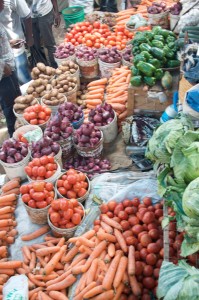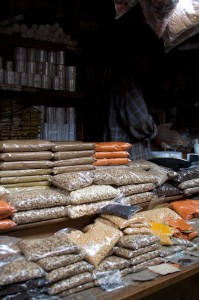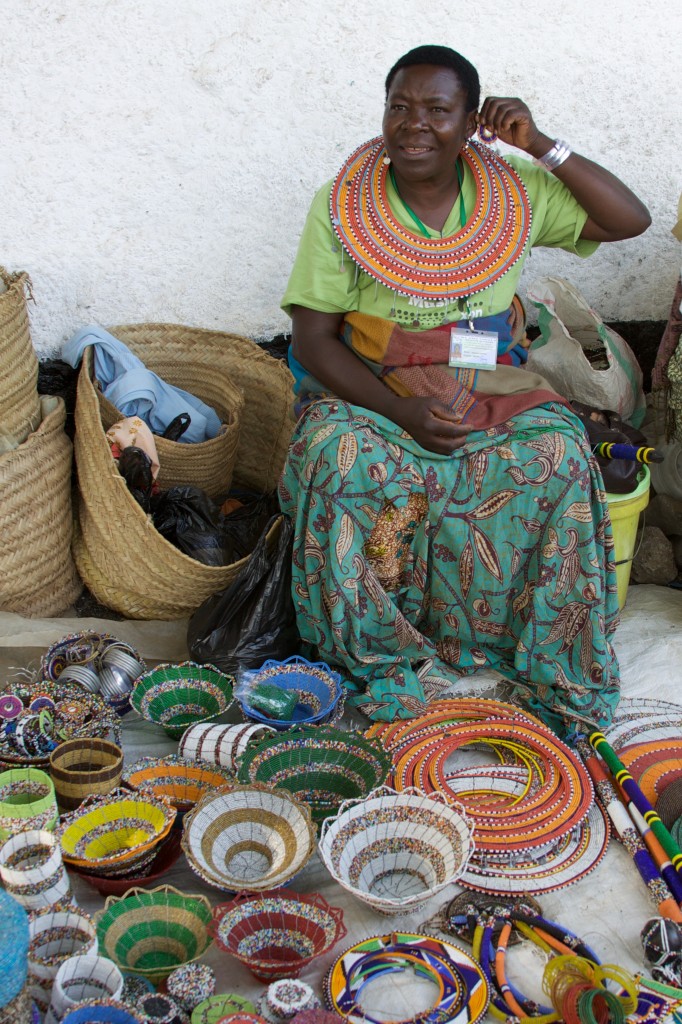The crowds seem to converge under the massive wood and tin structure looming ahead: the Arusha market. It is here that fresh fruits and vegetables, smoked fish, dried beans and rice, and baggies of aromatic spices are brought, showcased, and sold every day. In the fresh food area, women wrapped in brightly patterned kanga sit on stools in front of their stalls with broad, shallow baskets full of freshly shelled peas in their laps. Gregarious shouts of greeting and warbled Swahili haggling fill the air around me. Riotous colors – piles of orange carrots, red tomatoes, green heads of cabbage, yellow bananas, purple onions, white potatoes – assault my senses. Two stories above, the blue tarp ceiling filters the light and shades everything with a slight shade of blue.

I am in Arusha, Tanzania, preparing to head out into the bush near Tarangire National Park to begin my thesis research. I’m working with the African People & Wildlife Fund to estimate the size of the lion and leopard population in their study area. Founded and lead by an F&ES graduate, Dr. Laly Lichtenfeld, APW works with Maasai communities outside Tarangire to reduce conflict with large carnivores. Today, June 5, APW staff are stocking up on food and other supplies, so I have a free day to explore Arusha with the two other interns who are also working with APW this summer.
Our guide, Michael, an Arusha local, gestures to us to follow him through the building at the back of the fresh food area. We emerge into what looks like an old warehouse and find the dried goods. The smell emanating from rows of neatly stacked smoked fish is overwhelming, although not entirely distasteful. Enormous piles of tiny dried sardines, rice, and beans sit on raised platforms so they tower above my head. The vendors sit behind their wares, above the milling customers. We’ve attracted quite a crowd, so now there are about a dozen strangers following us around, explaining everything and exclaiming “Take picture! Take picture! Picture free!”
Next it’s on to the spice area, one of my favorites. Cellophane bags of every imaginable spice, whole and crushed, are stacked like playing cards along the narrow, twisted corridor. Here the ceilings are low and the light filers murkily through thick plastic sheets. It’s much quieter in this area, and people must squeeze to pass us while we smell the spices of one particularly friendly vendor: garam masala, ginger, cardamom, saffron, black pepper (which makes me sneeze), star anise, curry, and several others I don’t even recognize.
After the food market, Michael takes us to the Maasai craft market. It’s a quiet Thursday so we’re the only tourists there, and the

vendors are eager to attract our attention and business. They reach out for my hand as I pass by, rushing to place fabric over my shoulder, and hold earrings up to my ears to demonstrate how beautiful their wares are. Here, the narrow alleys are named after famous Tanzanian parks: Serengeti, Ngorongoro, Tarangire, Ruaha. The stalls, little one-room alcoves lined with shelves, are stocked with all manner of handicrafts. Exuberantly patterned handmade fabric bags hang from the ceiling, along with parachute pants and dresses. Acrylic paintings on cream-colored canvas – depicting scenes of Kilimanjaro and of Maasai women carrying baskets of fruit on their heads – blanket the walls. The shelves are weighed down by every imaginable wood carving: globes of all sizes, goblets with elephants on them, picture frames, chess boards with lions for the kings, bowls of every shape and size, bookends, miniature statues of the most popular animals, carved masks – some antique, some made to look so – even six-foot tall giraffes that tower over my head.
This market is perhaps even more overwhelming than the food market, because the vendors are not shy about talking to us and try to convince us to purchase things. “Rafiki,” they say, “friend – please help support me and my family. My two young children depend on it.” I have no room for any trinkets at the moment, and want to save souvenir shopping for the end of the trip, but I do purchase a fabric bag from one woman, and an abstract painting of two zebra from another. The last woman we visit is sitting behind her beaded wares like a Buddha, and she eagerly puts on all the different types of jewelry she sells to show us how beautiful they are. I buy an anklet from her, one that twinkles cheerfully when I walk.
Our day at an end, we head back to our hotel for cold Cokes. Tomorrow we head to Noloholo, the bush camp where I’ll be living for the next ten weeks.
Baadaye (later)!
Kelly
